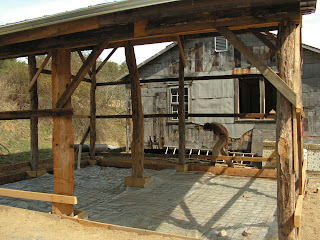Farming is very material: Wood, lumber, metal, dirt, soil and rocks, heavy by the shovelful, tin roofs torn from old houses, outbuildings, storage space, rain-soaked piles of objects, heaps and mounds of material for later use.
Consider the immensity of plant material a single bovine consumes per day: 60 to 90 pounds of grass, roughly approximate to the amount going out in urine, milk, and manure (+ the 25 gallon *slurp* of water). Miraculous! Water, sunlight, soil, thousands of pounds of grass and clover grow in a single day, one hour, one minute! Don't forget the pasture weeds, ragweed, cockleburr, pigweed, partridge pea, ironweed, asters, goldenrod, burdock, too many to count, rising soft, innocent, then popping up into hard stalks and sticky seeds, awful!
Yesterday, a concrete mixer backed up a new gravel road, slightly steep, with 14,000 pounds of concrete. Combining the weight of the truck that's 42,000 pounds coming up a hill of loose gravel--in reverse! I'm grateful the contents of the truck made it up the road and did not require a 'middle-movement' of men with shovels and wheelbarrows to pour a slab of 500 sq. ft. Now we're ready to timber frame the roof of an addition to the milk shed. After the roof, straw bales are likely candidate for walls. Keep posted.
Farming is expensive. In my transition from college--I finished just 8 months ago--straight into 'self-employment' I've discovered there seems to be a fine, razor's edge line between investing in big stuff like buildings, barns and farm equipment, cows, ducks and chickens and making a living: the things like food, car insurance, phone + electric bills, rent. It seems, fortunate for them, that farmers often have a comparably lower cost of living than other people, considering the amount of thrift that comes with the job and the quantity of food one can produce on a small piece of land. However, without some significant financial contributions from a few people, the farm would not have been able to invest in stuff like cows, the milk parlor, a new truck, and an addition to the milk barn this first year. I would like to list those individuals and family members below followed with what their contribution made it possible to purchase.
James F. Steen
- Dana, the first milk cow
- 4/5 of a 4x4 Chevy truck
- Remesh and rebar for a slab foundation
- Lumber for the milk barn
- Blueberry plants and apple/pear rootstocks
- 1/2 of a STIHL weedwhacker
- Attorney & surveyor fees to close on the purchase of 10 acres for the farm
- Boots
- Steel Buckets
- 1/2 of a STIHL weedwhacker
- Assistance with the cost of concrete truck for a slab
- Books on Cattle Health
- Nearly all of the equipment needed to put a 6-strand high-tension fence around 20 acres of pasture. This fence will be started this winter and be approximately 3,800 feet in perimeter and make it possible to intensively rotate animals and improve the pasture.
- Bulldozer work and gravel for a new road 100 ft long
- Part of the concrete cost for a slab
- Repair cost for a Poulan chainsaw and use of his Husqvarna saw
- Three beautiful Locust logs, now supporting a barn roof
_______________________________________________________




















 all for now
all for now





